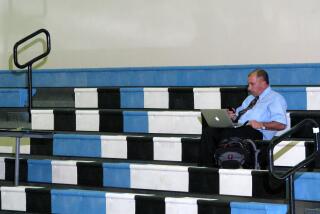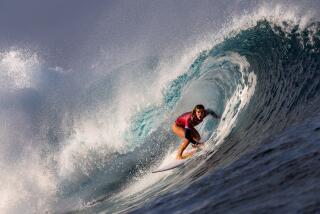Daredevils of surfing’s ‘jet set’ go to extremes
The waves at Teahupoo are measured more by thickness than height, a sign of the cyclonic energy building within. They are some of the heaviest waves on the planet.
They approach the small Tahitian community at up to 60 mph, depending on the severity of storms hundreds or thousands of miles away. The same storms propel swells to Southern California, where a mostly sandy, gradual shoreline typically grooms and slows them considerably before they break.
But at Teahupoo, the waves build suddenly and massively. About 400 yards from shore, a large coral reef rises to about six feet beneath the surface at low tide, and 100 yards beyond the reef, the ocean depth drops precipitously to nearly 2,000 feet.
A wave responds dramatically to such abrupt changes in depth; its energy is shoved suddenly into a much shorter water column.
On a sunny morning last August, the waves became heavy even by Teahupoo’s standards. One wave in particular stood out, bringing with it what seemed the weight of the ocean itself.
As it pushed against the reef, its face rose to about 25 feet. It formed a heroic arch, drawing water from the reef with such force that the coral seemed to be tearing free of its roots. Water loaded at the top as a “lip” more than 10 feet thick.
Still moving, top-heavy beyond belief, an unfathomable amount of seawater began to collapse violently.
Seawater weighs 64 pounds per cubic foot. There would be serious consequences for anyone caught in the middle. This was more than Mother Nature’s version of a ton of bricks; it was the Queen Mary falling out of the sky.
Three months earlier, a similar crusher came out of the blue. A surfer was caught inside and paddled furiously to make it up the face, but he got thrown over the falls and slammed onto the reef. He suffered puncture wounds to his skull, a broken neck and spine, and a gash from the cleft of his chin to his sternum. He died three days later.
But on Aug. 17, when all the waves were that big and with virtually everyone scared out of the water, one surfer still wanted to be in the middle, having spent most of his life preparing for such an opportunity.
The massive wave would break perfectly and resoundingly to its left, like the others, but it would be much faster and form a barrel much more hollow.
The experience of a lifetime awaited. The challenge was to get into the wave fast enough to negotiate the near-sheer drop, perhaps make a split-second entrance into the barrel, and stay on the only course that would afford a safe exit. There would be no room for error.
He launched onto the back of the wave with the help of a partner aboard a jet-powered ski. He let go of the rope at about 30 mph, zipped down the face, ducked under the lip and fought for what seemed an eternity to hold his line, against an upward pull threatening to yank him out of this world.
New Frontiers in Surfing
The surfer risking his life was Laird Hamilton, one of the lords of the new and extreme sport of tow surfing.
With high-speed personal watercraft for transportation, tow surfing’s elite few have eliminated the need to paddle and can handpick the waves they want to ride. The drivers either pull the surfers directly onto the rising swells or attack them head-on, carving 180-degree turns atop their cresting peaks and “whipping” them shoreward at 30 mph to 40 mph, enabling them to glide into position as the waves begin to break.
With customized boards fitted with foot straps, they’re not only dropping into ocean rollers that had previously been deemed too big, too fast and too powerful to ride--they’re carving them up, performing turns and cutbacks, and tucking into tubes hollow enough to drive a bus through.
Purists cringe at the sight of tow surfers, labeling them cheats, pointing to their lack of etiquette, and to the noise and pollution they bring.
But tow surfers counter that they’ve discovered a wild new frontier.
“Life’s too short not to be creative and try new things,” said Hamilton, 37, who has been riding water since birth. He was born in a bathysphere as part of an experiment to determine the effects of gravity on newborns.
His parents, both surfers, moved from San Francisco to Hawaii before Laird turned 1. When he was 2, his father, Bill Hamilton, taught him to surf on the front half of his board.
When he was 8, his father took him to Waimea Falls on Kauai to show him the famous place where men and much older boys leaped to prove their manhood. Hamilton stood at the edge and jumped 60 feet into the pool below, to the astonishment of his father, who brought the boy merely to watch.
It was then that Bill Hamilton knew he had a son who was “hell-bent on living life to the extreme.”
Extreme certainly described the conditions off Teahupoo during the mid-August swell. Hamilton had wiped out twice, hitting the reef hard enough once to cause bloody imprints on his legs and badly bruising an ankle. He wasn’t aware of it at the time, however--there was too much adrenaline ripping through his veins.
He began his life-or-death dash on the biggest wave of the day after being “whipped” onto its hulking shoulder more than 60 yards deep.
He dropped down its face and fought against its pull until the pressure within the wave was released in the form of an explosive plume of mist. Hamilton emerged from the “spit” into the channel, still on his feet.
He enjoyed only a brief moment of celebration before putting his face in his palms and crying.
“You have to understand that at Teahupoo that day, I knew . . . I knew in my heart that if I didn’t make that wave there was a good chance, a better-than-good chance, that it would have been over,” he said. “I mean, if you didn’t hit that wave just the right way, you’re leaving limbs behind--and there are no hospitals nearby.”
We got into it to get . . . away from all these guys, to not have to deal with the b.s. You’ll have 100 people out at Waimea and 90% of them are Brazilians who say ‘No Fear’ but we say ‘No Brains.’ You’ll have six guys in front of you and six in back. I might as well have road rage over in Ventura or something.
--Darrick Doerner, Haleiwa, Oahu
During the mid- and late 1980s, Waimea Bay on Oahu’s North Shore was the mecca for big-wave surfers. More people were arriving every winter, to surf not only there but at Sunset Beach, Pipeline and several lesser-known breaks.
In 1991, Hamilton and Maui surfer Buzzy Kerbox began to experiment at Hawaii’s outer reefs. They used Kerbox’s inflatable outboard to scout around. Both had already experienced the thrill of riding those breaks on sail boards, using the trade winds to generate enough speed to catch and stay in front of the breaking waves. But when they took turns towing each other into those breakers, riding them free of a sail board’s restrictions, they realized immediately the potential tow surfing held.
Doerner caught a glimpse of what Hamilton and Kerbox were doing and quickly jumped aboard.
They called themselves the three amigos, dumped the inflatable in favor of a much faster jet-powered ski, and enlisted the cooperation of surfers and board-sailors Dave Kalama, Mark Angullo, Rush Randle, Mike Waltze, Brett Lickle and Pete Cabrinha.
They went to work, shrinking traditional big-wave boards from about 10 feet to 7 1/2 feet, narrowing them from more than 20 inches to about 16 inches, and weighing them down at first with lead and later with extra layers of fiberglass for stability at high speeds.
Borrowing techniques from North Shore lifeguards, they attached rescue sleds to their vessels, learned how to drive them and how to tune and repair them in emergency situations.
“It goes from being a sport that has always been so free and unfettered--[to something] so much more complicated,” said Bill Sharp, publisher of the Costa Mesa-based Surf News. “I mean, you have to be a total gear-head. You have to maintain your machine and know how to deal with the myriad of technical problems.”
Hamilton and company practiced their driving and water starts, their tow-in and pickup techniques, first on smaller waves and then on the really big ones.
They eventually attempted a deep-water break off Maui called Jaws, where the reef catches fast-moving north swells. They rise up swiftly, throw out hard and smash in a thud that can be heard for miles.
Photos of Hamilton and crew screaming down 40- to 50-foot faces and carving incredible turns at Jaws were plastered on the pages of surfing publications around the world. During the winter of 1996, Doerner became the first to duck into one of Jaws’ hollow, grinding tubes, and emerged still on his feet.
“That day, we cut the yellow ribbon,” he said.
Jaws was expected to kill and nearly did on several occasions. With every wipeout was a potential victim. One of the most dramatic involved Hamilton’s now-ex-wife, Maria, who went out on a big day in 1993 with Kalama as her partner, against her husband’s wishes.
She took a savage wipeout at the beginning of a set and bobbed up and down, in an impact zone swirling with foot-high foam, being pounded by successive waves while Kalama and others frantically dashed in and out of the zone looking for her. They finally found her and pulled her to safety, as she was gasping for air.
“That was the end of her tow-in career,” Hamilton said.
The incident drove home the dangers of the sport and illustrated just how important the relationship between the driver and surfer is.
“It’s an unspoken bond,” Hamilton said. “Nothing is so crucial. Friendships are nothing if that friend isn’t willing to put his life on the line to save yours.”
You want to know what it was like? Look out your car while driving 35 mph, and then jump out and have a block-long, eight-story building fall on you.
--Ken Bradshaw, Sunset Beach, Hawaii
Whereas Hamilton is credited with conquering the “heaviest” wave to date, at Teahupoo, Bradshaw, 48, is credited with riding the biggest, at an outer reef off Oahu called Outside Log Cabins.
Like Hamilton, Bradshaw is obsessed with riding big waves. To increase his stamina, he carries boulders while holding his breath and running along the ocean floor.
On Jan. 28, 1998, the North Shore shook under the effects of a gargantuan swell.
The faces of Waimea breakers were towering 50 feet high in a straight line across the bay. Bradshaw and partner Dan Moore charged through all this on their jet-powered ski, to the Outer Log Cabins.
A few other teams joined in the session, and “every single wave we rode that day was probably bigger than any we’d ever ridden before,” Bradshaw said. “Normally, we let go of the rope at 26 to 28 mph, on a normal 20-foot day. And this day, we were letting go of the rope at 30 to 35 mph.”
Then a rogue wave formed on the horizon, a skyscraper estimated at 85 feet. When it began to break, Bradshaw was on its back.
“I let go of the rope at like 35 mph and the thing was still building,” he said. “I dropped in for like five seconds and then the whole thing hit a ledge and went absolutely vertical. It just hollowed out, and I remember just fluttering down the last half of the face.
“I was just trying to keep my edge in the water, with all my strength . . . I was thinking to myself, ‘I can make this, I can make this . . .’ ”
He made the drop, at a speed he estimated at more than 50 mph, and then managed a bottom turn and cutback.
Moore drove in, tossed Bradshaw the rope and pulled him to safety.
“We went into the channel, stopped the machine and just sat there,” Bradshaw said. “We were just so elated.”
When all that power starts unloading around you it’s . . . energy, man. Your fingertips are freakin’ sparkin’, you know?
--Jeff Clark, Santa Cruz
Clark surfed the 40- to 50-foot cold-water break off Half Moon Bay, Calif., alone for 15 years before others got up the nerve to make the half-mile paddle past Pillar Point to a spot called Maverick’s.
Maverick’s was thrust into the international spotlight in 1994, when it claimed its first victim: Hawaii’s Mark Foo, who had paddled out and failed to surface after a dramatic wipeout. Foo’s board was found hours later, his body still attached to its leash, submerged and lifeless.
Seven years later, Maverick’s is a mecca in its own right, not only for paddle surfers but for a growing crew of tow surfers. With every big swell comes the inevitable roar of the jet set.
“They’re like a gang of teenagers hanging out at 7-Eleven,” said Mark “Doc” Renneker, a Bay Area physician and Maverick’s regular. “They won’t tow into waves [we’re trying to paddle into], but they always let you know they’re there, strutting their stuff by doing doughnuts or whatever.”
Those who have taken up the rope are among Maverick’s’ most accomplished paddle surfers, including Clark, Peter Mel, Ken “Skindog” Collins and Darryl “Flea” Virostko.
Like Hamilton, they’re quick to dismiss criticism. “You can either shoot bow and arrows at the dragon or take up the sword and go after it,” said Clark, who owns a surf shop in Half Moon Bay. “That’s the difference [between paddle surfing and tow surfing.]”
They point to Oct. 28, 1999, as a “groundbreaking day because it was a day that no paddler could even get out,” Mel said. “It was a day of all days. The first waves I rode were the biggest things I had ever seen. And the thing I remember most is the speed: How much speed you’re having while riding this wave is like no other speed you ever felt.”
Mel’s final wave that day was his largest, cresting at about 70 feet, according to one witness. Collins had whipped him onto its shifting shoulder and driven his ski over its fluttering peak, and so far down its back that he feared for Mel’s life because of the enormous amount of water pushing the surfer shoreward.
Mel’s legs burned as he flew down its near-vertical face. Suddenly, he found himself straightening out at the bottom, where he faced the prospect of stalling and being buried alive. He used the remaining strength in his legs to turn to his right, zipping back up the face and finding the perfect line to stay just in front of the break.
Collins was in the channel to pick him up.
“I said, ‘OK, I’m done,’ ” Mel said. “I felt like I had just jumped off a cliff and survived. I wasn’t going to push it any farther.”
There’s a huge fear factor. At a spot like that, you don’t want to make a mistake. That was kind of our motto. For me and Brad it was “no mistakes” because a bad mistake, we realize, could cost you your life.
--Mike Parsons, San Clemente
Parsons, 35, is a big-wave veteran who only recently “took up the rope.” He and neighbor Brad Gerlach acquired a $15,000 jet-powered ski two years ago and practiced extensively on deserted waves off Camp Pendleton.
In early January, they became the first to practice tow surfing at Todos Santos Island off Ensenada, on waves measuring 50 feet from crest to trough.
A few weeks later, they journeyed to Cortes Bank, a seamount located about 100 miles west of Dana Point, one that almost breaks water at low tide.
Larry Moore, now a photo editor for swell.com, organized the expedition involving assorted media and the tow-surfing teams of Parsons-Gerlach and Mel-Collins. They arrived at dawn Jan. 19 aboard the 54-foot Pacific Quest. The waves appeared first as blips on the radar screen, then as rolling groundswells and finally, at first light, as breaking waves with faces measuring 30-plus feet.
Though two paddle surfers were on hand, Capt. John Walla and swell.com editor Evan Slater, Cortes soon turned out to be “Towville,” as Walla described it. Parsons got the ride of the day, on a wave with a face measuring about 60 feet. His 7-foot 2-inch board became, according to Slater, “a small black seed at the bottom of a giant blue salad bowl.”
Parsons stalled briefly in the trough after the drop, but then leaned in and generated a burst of speed that enabled him to kick out 100 yards from where he was towed in.
His mind is already on next winter, on a magic number previously thought unattainable.
“I do think there will be a time when someone rides a wave that’ll probably be 100 feet on the face,” he said. “I think that day is coming pretty soon, actually. I really do.”
More to Read
Sign up for The Wild
We’ll help you find the best places to hike, bike and run, as well as the perfect silent spots for meditation and yoga.
You may occasionally receive promotional content from the Los Angeles Times.










